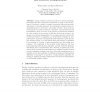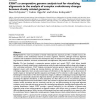64 search results - page 5 / 13 » Finding approximate tandem repeats in genomic sequences |
ALMOB
2006
13 years 7 months ago
2006
Background: Discovering approximately repeated patterns, or motifs, in biological sequences is an important and widely-studied problem in computational molecular biology. Most fre...
BMCBI
2006
13 years 7 months ago
2006
Background: Genome sequences vary strongly in their repetitiveness and the causes for this are still debated. Here we propose a novel measure of genome repetitiveness, the index o...
RECOMB
2006
Springer
14 years 8 months ago
2006
Springer
Abstract. During evolution, genomes are subject to genome rearrangements that alter the ordering and orientation of genes on the chromosomes. If a genome consists of a single chrom...
BMCBI
2006
13 years 7 months ago
2006
Background: The recent accumulation of closely related genomic sequences provides a valuable resource for the elucidation of the evolutionary histories of various organisms. Howev...
BMCBI
2007
13 years 7 months ago
2007
Background: Sequencing of prokaryotic genomes has recently revealed the presence of CRISPR elements: short, highly conserved repeats separated by unique sequences of similar lengt...


